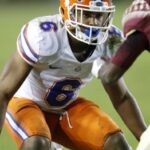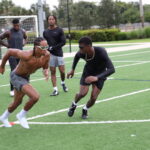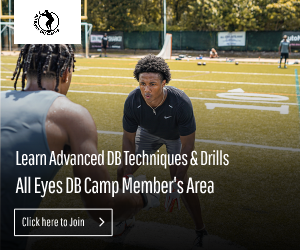By now, we’re all aware of some of the common mistakes made when playing press man coverage. These include things like opening the gate, having your eyes too high, and getting on your heels. However, even after addressing these issues, you may still encounter problems from time to time that can be frustrating. In this article, we’ll discuss three small things that you may be doing wrong that could be affecting your press man reps.
1. Using the wrong hand at the line of scrimmage
I get it; sometimes, using the hand nearest to the wide receiver when he is getting outside your body seems smart. After all, it’s the hand with the best chance of touching the receiver, and your coach is always saying, “get a jam.” However, relying on the near hand can be costly in the long run. When you use the near hand, chances are you will plant that same foot. If that foot is planted, your hips are locked, initiating a bad chain of events.
If you were to take a picture of what that looks like, it wouldn’t be good. The receiver is facing down the field, and you are facing in the opposite direction. Unless that receiver is strapped to a 45-pound plate, he’s going to beat you down the field. There’s always the chance that you got a strong enough jam with one hand to knock him off balance and give yourself a chance to open up. However, even for a risk-taker like myself, this is far too risky. Instead, make good use of your kick slide, and use your opposite hand to jam the wide receiver when close enough to do so. This allows your hips to open and keeps you over the top or at least even with the wide receiver as he progresses down the field. I have great information on perfecting your kick slide in the All Eyes DB Camp members area.
2. Not controlling the space during the route
It is a common mistake for young defensive backs to want to glue themselves to the wide receiver as early as possible during the route process. Understandably, you think the ball may be coming at any moment. However, experience will tell you that this is not the case. Certain releases determine certain routes.
Wide receivers would love to have you up against their body as they run the route. This gives them the opportunity to push off on you and get separation as the ball is coming. As a defensive back in coverage, allow yourself some space (typically arms length away) so that the wide receiver cannot push off on you. Sure, it’s supposed to be a flag, but you know that getting a call for offensive pass interference is very difficult to achieve. Do yourself a favor and keep a little bit of space between you and the wide receiver until the ball is on its way. It is then that you want to close that space out and get your body up against his to defend the throw. There are some other great benefits to keeping that space during the route too. I go in-depth on this topic in my book “101 DB Tips.”
3. Not finding the ball
There is an inherent fear by most defensive backs when they are running down the field with a wide receiver that looking for the ball will allow the wide receiver to catch it. Nothing could be further from the truth. When you are in hip-to-hip position, commonly known as in-phase, and the wide receiver is looking for the ball, this is an indication for you to do the same.
Too many defensive backs will run down the field and refuse to look back for the ball. Instead, they opt for playing the hands, and this can become a problem. Typically, the defensive back fails to time the arrival of the ball correctly, so one of two things happens. Either he does not do enough to disrupt the throw, and the receiver catches it anyway, or what is more common, the DB makes contact with the wide receiver too early and draws an interference flag.
Make it a habit to turn your head when you are in position and play the ball. You have just as much right to it as the receiver does. Switch your mentality to being a receiver when the ball is thrown and watch how much better you become at defending the deep ball. You should also combine this practice with engaging in a healthy amount of ball drills in your time on the field. It is important to get comfortable with tracking throws so that you don’t panic in those situations.
Paying attention to these three subtle factors—using the proper hand at the line of scrimmage, controlling the space during the route, and looking for the football—will definitely increase your win rate in your press man reps. Get to work on these and try them out in practices and camps. There’s little doubt that you will see a significant improvement in your results. As mentioned in the article, you can get more in-depth information on these principles in either the All Eyes DB Camp area or the book “101 DB Tips.”
Chad Wilson is the owner of All Eyes DB Camp and author of "101 DB Tips". He played college football at the University of Miami and briefly in the NFL for the Seattle Seahawks. Over his 15 year high school football coaching career, he tutored over a dozen Division I defensive backs and as a trainer has worked with NFL All Pros, first round draft picks, college football All Americans and Top 10 ranked high school football prospects.









